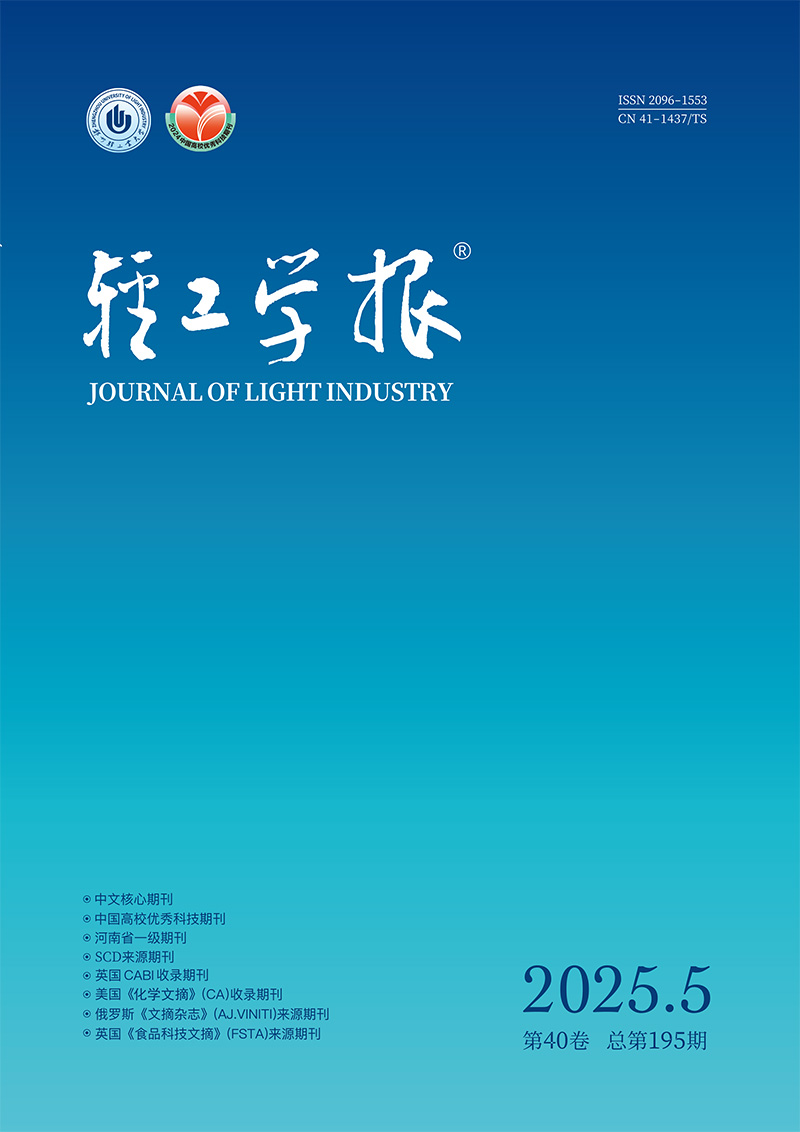2020 Vol. 35, No. 6
Display Method: |
By employing a site-specific mutagenesis strategy for glycerol kinase (encoding by glpK), the active-site residue Met270 was replaced with Ile in the Bacillus subtilis genome. A mutant strain Bacillus subtilis M270I was constructed successfully by using the markerless gene replacement system. The results of growth analysis indicated that the mutant strain got a higher level of glycerol utilization. Compared with the control strain Bacillus subtilis 168 Δupp, the mutant strain exhibited higher specific growth rate (increased by 11%) and higher biomass yield (improved by 16%) with a shorten lag phase (shorten 2~4 h) in the M9 glycerol minimal medium.
Using seaweed residue as raw material, the fucoidan sulfate was extracted by acid extraction. The extraction process conditions were optimized through single factor experiment and orthogonal experiment. In order to achieve the purification of the crude fucoidan sulfate, the optimal ethanol precipitation volume fraction was screened in combination with the Dische colorimetric method. The results showed that the optimal process conditions for extracting fucoidan sulfate from seaweed residue by acid extraction were HCl concentration 0.25 mol/L, extraction temperature 50 ℃, extraction time 2 h, and material-liquid ratio 1: 10. The extraction rate of crude fucoidan sulfate was 1.89%. Combined with the Dische colorimetric method, the optimal ethanol precipitation volume fraction was 70%. At this time, the mass concentration of fucoidan sulfate reached the maximum, which was 3.12 μg/mL.
Based on the demonstration of molecular imprinting technology,photonic crystal technology and the technology of molecularly imprinted photonic crystal,the relevant researches on the application of molecularly imprinted photonic crystal technology in the detection of toxic and harmful substances in food (veterinary drug residues,pesticide residues,biological toxins,endocrine disruptors,illegal additives) and nutrients was combed.It pointed out that molecularly imprinted photonic crystal technology combined the high selectivity of molecular imprinting technology to the target and the unique optical properties of photonic crystals,and was suitable for food detection as a new optical sensor.Compared with the traditional food detection methods,molecularly imprinted photonic crystal technology greatly improved the detection efficiency,shortened the detection time,improved the visual detection degree,and was more conducive to the development of field detection.However,molecularly imprinted photonic crystal technology also had the disadvantages of complex synthesis process,large amount of organic reagents,narrow detection range and poor repeatability.Researchers could make further research in the future on developing environment-friendly green synthesis methods,enhancing the stability and controllability of photonic crystals,reducing the nonspecific adsorption of molecularly imprinted photonic crystals,developing high-throughput detection methods suitable for simultaneous detection of multiple targets,and expanding the application in the field of microbial detection to optimize and develop molecularly imprinted photonic crystal technology.
The structure of tobacco stems from He'nan province was characterized by chemical composition analysis,infrared spectrum analysis and crystallinity analysis.The thermal decomposition characteristics of tobacco stems were studied by thermogravimetric analysis,and the pyrolysis kinetic parameters were also calculated.Results showed that there were typical biomass components in tobacco stems,and the contents of cellulose,hemicellulose,lignin and pectin were 28.15%,20.01%,5.67% and 5.32%,respectively.There were characteristic structural groups of lignocellulose in tobacco stem.The crystallinity of tobacco stem was 25.37%,which indicated that the pyrolysis reaction of tobacco stem was easier to be carried out.During the pyrolysis of tobacco stems,the weight loss of cellulose,hemicellulose and lignin were 18.83%,17.89% and 15.06%,respectively.Corresponding activation energies of pyrolysis reactionswere 31.72 kJ/mol,27.82 kJ/mol and 58.99 kJ/mol,respectively.The pyrolysis of cellulose and hemicellulose were dominated by a first-order chemical reaction,while lignin pyrolysis was controlled by a third-order chemical reaction.
The effect of different microorganisms (lactic acid bacteria RG,lactic acid bacteria MSA,lactic acid bacteria FL,Bacillus KC,Bacillus ND,Bacillus JD) on the pH value and cell wall components (pectin,cellulose,hemicellulose and lignin) of tobacco stem was studied by enhancing the solid-state anaerobic fermentation of tobacco stem.The results showed that solid-state anaerobic fermentation could reduce the pH value of tobacco stem to varying degrees,and the pH value of tobacco stem fermented by lactic acid bacteria was reduced from 6.05 to 4.50~4.60.After 4 days of fermentation,the degradation effect of lactic acid bacteria RG on pectin degradation was the most obvious and the degradation rate of pectin in tobacco stem reached 87.75%.The degradation effect of lactic acid bacteria MAS on cellulose was the most obvious and the cellulose quality score decreased from 20.83% to 15.90%.Bacillus JD had better lignin and hemicellulose decomposition effect and the quality score of lignin and hemicellulose decreased from 10.91% and 10.66% to 5.55% and 7.40%,respectively.
Through combing the research literature of slim cigarette processing technology and processing equipment in China,it was pointed out that the research on processing technology of slim cigarette was mainly focused on the local research of tobacco cutting and stem cutting process.Due to the lack of in-depth and systematic research on the three links of threshing and redrying,tobacco primary processing,rolling and wrapping process,the research on processing technology of slim cigarette was difficult to support the process system of slim cigarette.The processing equipment of slim cigarette was mainly the processing equipment of the conventional cigarette by branching transformation,which only met the basic requirements of processing technology of slim cigarette,and systematic research need to be carried out on the optimization design and the improvement of the processing quality of slim cigarette.In the future,a “big technology” concept should be set up that combines the three links of threshing and redrying,tobacco primary processing,rolling and wrapping process,and carry out a systematic research on the key technologies of processing technology,research and development of typical problem equipment,and the key technologies of quality control.The key technology and quality evaluation of index system of slim cigarette processing technology and equipment needed to be established in order to improve the processing technology level and realize the high quality development of slim cigarette.
Using nature polymer gelatin and methacrylic acid (MAA) as raw materials,and ammonium persulfate (APS) as an initiator,a gelatin/polymethacrylic acid (gelatin/PMAA) composite hydrogel was synthesized via free radical polymerization.The effects of different component mass ratios on the conductive properties,rheological properties and mechanical properties of the composite hydrogel were studied.The results showed that the conductivity of the composite hydrogels adjusted to 6.52×10-3 S/cm with the dosage of MAA increasing.The conductivity also varied with the deformation of the hydrogel,making gelatin/PMAA composite hydrogel in terms of strain sensor have great potential applications.When the gelatin/PMAA composite hydrogel contained gelatin of 12% and MAA of 10%,named G12PA10,it exhibited optimal rheological properties and mechanical properties:storage modulus G' was up to 18.0 kPa,elongation at break was 340%,and compression modulus was 2.37 MPa.As the dosage of MAA increased,the swelling equilibrium time and swelling equilibrium rate of the gelatin/PMAA composite hydrogel in deionized water were basically the same as those in PBS buffer.But when the dosage of MAA was lower,the swelling equilibrium rate of gelatin/PMAA composite hydrogel in PBS solution increased slightly.
The recycled polypropylene (RPP) and ethylene-octene copolymer (POE) were used as the main raw materials.The RPP/POE blends were prepared by melt blending method.The mechanical properties and thermal properties of RPP/POE blends as well as the effect of compatibilizers on the mechanical properties were studied.The results showed that with the increase of POE addition,the tensile strength and impact strength of RPP/POE blends increased at first and then decreased,elongation at break tended to increase first and then stabilize,but the flexural strength decreased gradually.When the addition of POE was 5%,the tensile strength of the blend reached its maximum 16.7 MPa.When the addition of POE exceeded 20%,the elongation at break reached 400%,the impact strength increased to 5 times of that of RPP,and the flexural decreased to 50 % that of RPP.Furthermore,the Vicat softening temperature of the blends decreased with an increase of the POE addition,and the introduction of POE had a little influence on the crystal structure of RPP,but had a baffling effect on the crystallization of RPP.Moreover,compared with PP-g-MAH,compatibilizer POE-g-MAH was more suitable for improving the strength and toughness of RPP/POE blends.
By reviewing the current research status of the interface reaction between the precision casting and directionally solidified TiAl alloy and the shell material, it was pointed out that the reaction mechanism and degree of interaction between graphite shell, high melting point metal shell, oxide shell, zirconate shell and molten TiAl alloy were as follows: The graphite shell had more severe interface reactions and serious C pollution; the preparation cost of high melting point metal shells was relatively high, and its actual use required harsh environmental conditions; oxide shell materials had a wide range of sources and relatively low cost. Compared with the commonly used CaO, Al2O3, and ZrO2 shells, the interface reaction between the Y2O3 shell and the molten TiAl alloy was the weakest; the zirconate shell had a weaker interface reaction, showing considerable application potential. In the future, the application of oxide shells and zirconate shells in the field of cast TiAl alloys should be researched.Focus could be put on optimizing the structure of the shell materials and developing more stable adhesive materials.
Aiming at the problem that the uncertain disturbance factors in the workshop production have an impact on the real-time execution of the scheduling scheme, a job shop scheduling scheme with place buffer under uncertain disturbance was proposed to deal with the disturbance factors in the production workshop system combining simulation technology with intelligent optimization algorithm.Normally distributed random variables were utilized to describe uncertain processing time, and uniformly distributed intervals were employed to describe the average failure interval time and average repair time.The place buffer's parameters before severely blocked equipment were adjusted to affect the maximum completion time.An uncertain scheduling simulation model for job shop production was constructed by Plant Simulation software and genetic algorithm was used to solve the model.The simulation results showed that the adjustment of the place buffer's time parameter could obtain the best fitness value, which verified that the proposed method could effectively reduce the impact caused by uncertain processing time and random machine failures during the workshop production scheduling.
Aiming at the low carbon job shop scheduling problem, a low carbon scheduling model of multi-objective flexible job shop based on genetic variable neighborhood hybrid algorithm was proposed. When calculating the carbon emissions of mechanical processing system, the carbon emissions directly generated by machine energy consumption and indirect carbon emissions from waste treatment were comprehensively considered. The objective functions of completion time, total machine load and carbon emissions were established. The multi-objective weighting method was used to sum up the objective functions. Finally, the genetic variable neighborhood hybrid algorithm was used to optimize the scheduling model. The simulation results showed that the model could reduce carbon emissions in the production process under the premise of ensuring the balance of completion time and equipment utilization, which verified the feasibility and effectiveness of the model.
By reducing the order of the established simple pendulum differential system, the sufficient conditions for the reduced-order synchronization of the single pendulum multi-chaotic system were obtained.The study proved that the fractional-order single pendulum multi-chaotic system was reduced-order synchronization under the appropriate controller.The value simulation results further verified the validity of this reduced-order method.
Using the concepts and theories of normal matrix, conjugate transpose matrix and singular value decomposition and so on, the matrix A suited to A*=-A3 was found to be diagonalizable ; other results on this kind of matrices such as distribution of the possible characteristic values, formula (A⊗B)*=(A⊗B)3, singular value decomposition and the sufficient and necessary conditions for the establishment of the formula were also investigated.

Founded in 1986, bimonthly
Administered by:The Education Department Henan Province
Sponsored by:Zhengzhou University of Light Industry
Editor-in-chief:Wei Shizhong
Executive Editor-in-Chief:Zou Lin
Deputy Editor-in-Chief:Qu Shuanghong
Edited & published by:Editorial Department of Journal of Light Industry
CN 41-1437/TS
ISSN 2096-1553
Address:136 Science Avenue, Zhengzhou City, Henan Province, China
Postal Code:450001
Tel:(086)0371-86608635
(086)0371-86608633








